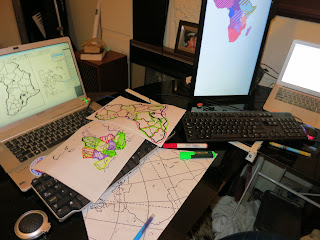Like many aspects of this the solution happened fast: Thank you VCarve!
The Offset tool would allow me to make what I called “Cut” lines. This would allow the lovely squigly country borders to stay.
Though the first set of challenging design decisions came out of this:
~ If there is going to be an offset, how will the real country borders be “printed”?
~ Countries girt by sea are fine, but how will borders be handled?
Around this point I was also coming to understand that the SVG Dymaxion projection didn’t have countries *on* it.
Sure, easy, I’ll just copy the SVG maps of the countries on a per continent basis on to the dymaxion project. Huh! How naive I was.
The project is skewed and slightly distorted. So are the country map SVGs.
There was no obvious easy way to overlay these. There was the long, hard way though.
What happened is I switched off my brain and spent hours and hours lining them up by-hand using Inkscape, as it’s a vector graphics editor that’s more powerful than VCarve (though also has its weaknesses!).
Gosh, I’ve learned a lot about vector software. Though not immediately, obviously.
Inkscape strength that really helped me was the ability to “Sculpt” nodes. This took a little while to get used to, and is a pretty simple tool (if you select a bunch of nodes and then move one, the nodes that are further away move proportionally less), but very helpful.
Getting the first continent I tried (Africa) lined up right right took … a very very long time. I spent 3+ hours at the Artifactory pushing, skewing, resizing back and forth then realising that I shouldn’t be using VCarve for this task and making a start on doing this in Inkscape.
The first priceless thing I learned was that by clicking on an object you can scale it. But clicking once *again* you can skew it. Yeah. Starting at the ground floor.
Another factor was because there were soooo many vector nodes (10s thousands) if you weren’t zoomed right in it before you switched to node-mode if would load all the visible vectors and set the CPU to grindy-grindy. The longest wait for node selection would have been in the order of hundreds of seconds. Though the wait was worth it because in the end I was selecting large numbers of nodes (Chile and Norway I’m looking at you) to delete them to reduce resource load on the computer and because I just didn’t need these award-winning coastlines in that much detail (sorry Slartibartfast).
I also had to learn on what to focus on. It took me right to the very end to fight the compulsion to line up all the coastlines correctly. I only need internal country borders and where they meet the sea, which I spent ages meticulously lining up by comparing to google maps.
I didn’t do Eurasia until as late as possible so I could skill up as much as possible before taking on this beast. It was worth waiting too, because by this stage I deleting coastlines with reckless abandon and focussing on which lines mattered and deleting everything else as much as possible.
Just for the record at home I had to put an old windows box into commission, as VCarve is windows only. I literally found on the computer on side of the road with a working version of XP on it. I’d keep it around for exactly this kind of thing.
---














































